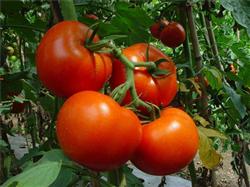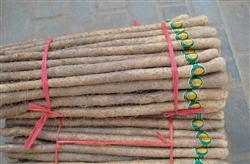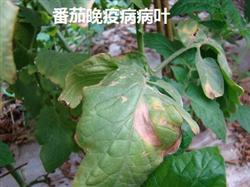Tomato planting techniques: how to grow tomatoes in autumn and winter?

How to grow tomatoes in autumn and winter? Please guide the planting of autumn and winter tomatoes in detail with reference to the following planting methods: first, do a good job of ordering seedlings in advance: according to the market sales, the planting time of autumn and winter tomatoes should be at the end of June and early July of each year. Therefore, the seedling raising time should be at the end of May and early June, so it is suggested that the majority of growers should seize the time to do a good job of seedling ordering. When ordering seedlings, we must inspect the seedling company and do a good job of "three looks", that is, to look at the technical strength of the seedling company to see whether it is really an expert; second, to see whether the seedling raising facilities of the seedling company, seedling bed, sprinkler irrigation facilities, disease prevention facilities, heating facilities, and cooling facilities are complete; third, to look at the new variety test of the seedling company and the production of tomato in the demonstration shed, and finally decided to plant the variety and the seedling company. Second, do a good job of deep furrow and wide border and water-saving irrigation techniques: the commonly used water-saving techniques in tomato production in autumn and winter are drip irrigation under plastic film and hidden trench irrigation. Drip irrigation under plastic film: before planting, a ridge with a width of 80 cm and a height of more than 30 cm is made, and the width of the upper mouth of the furrow between ridges is 70 cm. Drip irrigation is laid on the ridge, and the branch of drip irrigation is arranged in the east-west direction, the length is the same as that of the solar greenhouse. The capillary is arranged in the north-south direction (consistent with the planting direction, length 6-8 meters). Hidden trench irrigation under plastic film: after ridging, leave a 25cm trench in the middle of the ridge, with a slope from north to south, using water pipes to water and flush fertilizer along the dark trench. Greenhouse production and utilization of drip irrigation technology under plastic film must pay attention to change the concept of dripping water, from the concept of dripping water without dripping or dripping water, from the concept of dripping water to that of dripping thoroughly. The principle of frequent irrigation with small water, that is, to ensure that vegetables absorb water, and not to make crop roots soak in water and lack of oxygen, so in the vegetable seedling stage or low temperature season, 3-5 days, dripping one water, in the vegetable peak season and high temperature season. Drip water once every 1-3 days, and each drip should be carried out before 10 o'clock every morning, and the time of the first drip should be controlled between 0.5 and one hour. Under-film dark irrigation is also based on the principle of frequent irrigation of small water, dripping water for 7-10 days in seedling or low temperature period and 5-7 days in high temperature or high temperature period. Third, soil fertilization and soil testing formula fertilization technology: at present, the method of mechanical hitting the wall is mostly used in greenhouse construction, and the amount of soil is relatively large, which can basically be said to be sunny soil hitting the wall, coupled with the greater demand for nutrients for vegetable crops and a balanced demand for various large and micronutrient elements, so we must pay attention to the application of organic fertilizer and large particle organic matter in greenhouse production, and we should not pursue the use of chemical fertilizer unilaterally in production. To avoid secondary salinization of greenhouse soil. Therefore, fertilization must be carried out to determine the greenhouse soil nutrient status, according to the types of vegetables, cultivation methods, crop fertilizer law of reasonable formula fertilization. Organic fertilizer is combined with chemical fertilizer to balance a large number of elements of nitrogen, phosphorus, potassium, calcium and magnesium and trace elements such as zinc, boron, iron and copper, mainly with basic application and supplemented with topdressing. The base fertilizer uses farm manure which is fully ripened by composting at high temperature. The ripening method of organic fertilizer is as follows: 5-10 square meters of livestock manure are prepared in one mu, and 10-20 square meters of large granular organic matter (wheat stalk, rice husk, corncob, mushroom pool, crushed corn stalk, wheat orange stalk, rice orange stalk, etc.) are prepared per mu of land. In May-July of each year, livestock manure and large granular organic matter are mixed evenly according to the proportion of 1:2, and the water content is adjusted to 65% (hold it with hands and water ginseng can come out in the fingers). Then pile it into loess 1.5 meters wide and 1 meter high, and cultivate loess 5 centimeters thick on top, pat magnetically, compost at high temperature, turn the pile once in about 7 days, and mature organic fertilizer in 15-21 days. Spread the mature organic fertilizer evenly into the greenhouse from June to July every year, and then turn the greenhouse soil more than 30 centimeters deep before ridging and planting. Long-term use of mature organic fertilizer can not only provide a balanced supply of various nutrients for vegetables, but also reduce the harm of secondary salinization, especially it can make the ratio of soil C to N reasonable, increase the content of soil organic matter, increase soil looseness and air permeability, and facilitate the development of vegetable roots. 4. Selection of strong seedlings and scientific planting techniques: 1. Selection of strong seedlings: when purchasing seedlings, attention should be paid to fixing seedlings 30-50 days before planting according to vegetable species, varieties and seedling age, and suitable hole plates are required. 72-98 hole holes were used for eggplant fruits and melons, and 128-258 hole holes for leaf vegetables. The quality of seedlings should be carefully checked when they arrive. The criteria for strong seedlings are as follows: thick green leaves, broad and thick cotyledons and true leaves, thick petiole, about 1.5 ratio of length to width of cotyledons, ratio of length to thickness of hypocotyls about 12, ratio of cotyledons to Hypocotyl height above 1.5; good root development, good roots, no loose tuo, white roots, especially capillary roots, vitality, seedlings free from diseases and insect pests. 2. Scientific planting technology: when planting, open the planting hole according to the plant distance, as large as possible, pour enough water in the hole, wait for the water in the hole to dry, carefully and completely put the watermelon seedlings into the hole, the depth is 1 cm lower than the border surface, fix the seedlings with loose fine soil, and the soil block surface is covered with 1 cm thick fine dry soil and level with the border surface. After enclosing the soil, pour water again (about 0.5 kg per hole) to make the soil block contact with the surrounding soil tightly. Subsequently, it is necessary to check whether watering flushes the covered soil on the seedling block one by one, and if so, take fine dry soil to cover the soil again to prevent the loss of water from the matrix to damage the root system too quickly. Finally, the 1500-fold solution of Mizanling + 1500-fold solution of Shileshi was drenched along the stem below the cotyledons, and the roots were irrigated to prevent diseases such as quenching, standing blight, stem base rot, wilt and so on. The planting period of autumn and winter vegetables is in the first ten days of July, because of the high external temperature, we must do a good job of cooling: first, the greenhouse film before planting, which plays the role of shading and rain prevention, and all the upper and lower air vents are opened; second, the soil temperature must be reduced by dripping heavy water before ridging. After the seedlings are planted, they should be irrigated with small water according to the soil moisture. When the height of the seedling reaches about 30 cm, the water is controlled, and the trench is dug deep to facilitate the development of tomato lines. When the egg size of the first ear and the flower of the fourth ear begins to bloom, it enters the normal water and fertilizer management. Click to get more tomato planting techniques click to get more vegetable planting techniques
- Prev

Where is the origin of yam? What kinds of yam do you have?
How many yams are sold on the market, and where are the main producing areas of yams? What other kinds of yam do you have? Please introduce that there are four kinds of famous yams in China, namely: Changshan yam from Zouping, Shandong province; Tiezhan yam from Wenxian and Mengzhou, Jiaozuo, Henan; and Chenji yam from.
- Next

Tomato planting techniques: why does autumn tomato late blight occur?
Why does autumn tomato late blight occur? Please introduce the causes and control methods of autumn tomato late blight, which is a disease of low temperature and high humidity. The air relative humidity is more than 80%. The optimum humidity for the development of the pathogen is 20-22 ℃ in the daytime and more than 10 ℃ at night. Low temperature, overcast and rain, high humidity, more in the morning and night.
Related
- Where is it suitable to grow horseradish in China? it is expected to see the middle altitude horseradish in Alishan.
- How to prevent tomato virus disease reasonably? (Control methods included)
- Many people like to plant towel gourd on the balcony. What are the main points of this method and management?
- What crops can chili peppers be mixed with?
- Fertilization techniques and matters needing attention in Tomato
- What are the grafting techniques for peach seedlings in spring?
- Harm and control methods of root swelling disease of Chinese cabbage
- What are the pests of sweet potatoes? How to prevent and cure it?
- Symptoms, causes and Control methods of navel Rot in Tomato
- The cause of "Cucumber rotten bibcock" in Farmers' planting Cucumber and its Control Plan

